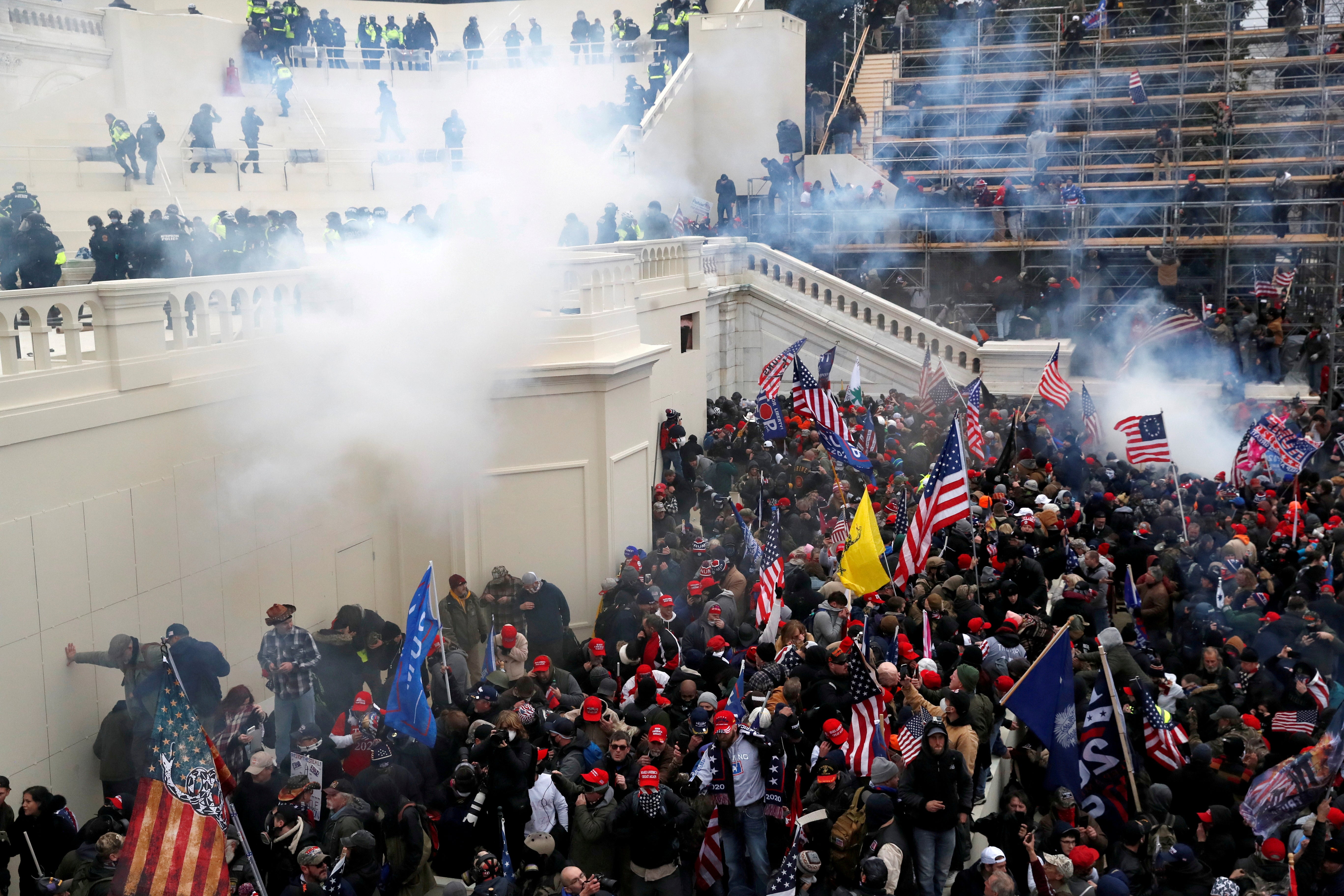A year after the Capitol riot, my cousin has a Nazi flag on his bedroom wall
We like to imagine that radicalized Americans are gun-toting hillbillies. Research shows how wrong that idea is, and how urgently we need to challenge it


Your support helps us to tell the story
From reproductive rights to climate change to Big Tech, The Independent is on the ground when the story is developing. Whether it's investigating the financials of Elon Musk's pro-Trump PAC or producing our latest documentary, 'The A Word', which shines a light on the American women fighting for reproductive rights, we know how important it is to parse out the facts from the messaging.
At such a critical moment in US history, we need reporters on the ground. Your donation allows us to keep sending journalists to speak to both sides of the story.
The Independent is trusted by Americans across the entire political spectrum. And unlike many other quality news outlets, we choose not to lock Americans out of our reporting and analysis with paywalls. We believe quality journalism should be available to everyone, paid for by those who can afford it.
Your support makes all the difference.“No one doesn’t know what a swastika means.” That’s a sentence I never imagined I’d be shouting in the opening days of 2022. And yet, there I was, arguing with two relatives about the Nazi flag currently displayed on my cousin’s bedroom wall.
They had found out about the flag quite by accident, walking in to say hi on a recent visit to his parents (with whom he lives.) And they were disturbingly blase about the whole thing. That’s not to say they were thrilled – there were even a little upset – but on the whole agreed with each other that it isn’t a big deal. “He doesn’t know what it means,” they kept insisting, calling him a “sweet kid” who just doesn’t “know better.” He is in his thirties, and he lives in the United States.
That white America – including my own family – still does not see the danger its hateful sons and daughters pose to the Republic is deeply concerning. A year ago today, radicalized Americans – at least some of them white nationalists – stormed the Capitol in Washington DC an attempt to overthrow our democratically elected government. The irony of this conversation happening so close to the anniversary of the January 6 insurrection was not lost on me.
Yet it is worth noting that the stereotype of racists and white nationalists as ignorant working-class kids, some led astray because they don’t know better – the same stereotype my own relatives tried to use to deflect blame from my Nazi flag-displaying relation – is wholly wrong. Americans have in their minds the image of a bunch of roughnecks with rifles holed up in compounds like Ruby Ridge when they imagine extremism. The research tells us that that’s a mistake.
As Alexandra Minna Stern, a professor at the University of Michigan, writes in her book Proud Boys and the White Ethnostate, today’s alt-right “is more international, suited-up, and image-conscious than its predecessors”. And according to Shannon Foley-Martinez – a former white supremacist who now helps others escape hate – many of those drawn to the movement are highly curious and intelligent, often grappling with major political questions. “A very large percentage of people, particularly young people [who get radicalized]… actually want to deeply engage with and grapple with big ideas. And a lot of times, that is part of their pathway in – that need and desire was not being met anywhere else,” she told PublicSource last year.
Looking at last year’s insurrection, many of those arrested came not from working-class families like my own, but from the so-called “upper middle class”. They include a realtor from Tennessee, a loan officer from Texas, and a CEO from Illinois. Richard Spencer – the father of the modern alt-right and a self-described white nationalist – has a master’s degree from the University of Chicago. Donald Trump regularly touts his own Ivy League education. These are hardly hillbillies.
The white power structure of America has never been upheld by the working class, though certainly they played their part, often as the violent foot-soldiers of the movement. White Citizens’ Councils throughout the South upheld Jim Crow in the 1950s and 1960s, pumping money and political might into upholding segregation.
This is part of what made integrating Ole Miss – a nickname for the University of Mississippi which is not a diminutive of the state’s name, but rather a nickname for a plantation mistress – such a major battle of the civil rights movement. The school, though academically middling, served as a finishing school for the white aristocracy of Mississippi. It wasn’t just any college; it was where future (white) leaders were sent to be trained to take their place as the men who ran Mississippi. Admitting Black students was as good as surrendering the future, and white Mississippi was not about to do that without a fight. Indeed, two men were killed in a riot when a Black man named James Meredith tried to register.
Even the Ku Klux Klan, which through much of the past half-century has been thought of as consisting of “poor white trash,” was founded by Nathan Bedford Forrest, a successful slaveholder and planter who was also a Confederate general. Yes, working-class Americans may serve as the foot-soldiers today – just as they did during the civil war – but they only do so in service to the true wielders of political power.
That is not an excuse for those who follow such poisonous ideologies – though I certainly believe my other relatives thought it was. My distant cousin is a young man alone in his room, they reason, who can’t even afford a place of his own in the foothills of the Appalachians. He is hardly Donald Trump, who is a much larger risk to national security. What harm can he really do with his isolated swastika?
And on that they may be right. But Timothy McVeigh was an itinerant young man who sold racist novels at gun shows before he blew up a federal building in Oklahoma City. We all have agency over our own thoughts and actions, and my cousin – like every white supremacist before him – has the agency over his.
That doesn’t mean the decision is always straightforward. The reasons people gravitate towards white nationalism are varied and complex. Foley-Martinez says she and others like her have “unprocessed trauma” which contributes to their radicalization. Certainly, alienation and the desire for a sense of community and belonging are known to attract people to everything from gangs to the Klan. Yet not everyone who is traumatized or lonely ends up with a swastika hanging in their room. And certainly not every lonely and traumatized person attempts to violently overthrow the American government.
Every person who stormed the Capitol a year ago had family who loved them, who thought they were “sweet kids” who didn’t “know better.” Ashli Babbitt’s grandfather called her an “excellent patriot”. People who knew Roseanne Boyland, the woman who had a heart attack and died that day while joining the insurrection, described her as a “sweet girl”. Ignoring those who join in with dangerous movements, however much we love them, is a luxury we can no longer afford.
We know now that both Ashli Babbitt and Roseanne Boyland showed signs of radicalization before January 6. Both were known adherents to the QAnon lie, with Babbitt wearing a T-shirt saying “We are Q” to an earlier event. Their families were aware of their beliefs, too: Boyland’s begged her not to attend the “Stop the Steal” rally that turned into a riot.
It’s hard to say what would have happened had Boyland heeded their warnings. Perhaps she would have realized she’d been sold a bill of lies. Or perhaps she would have continued down the radicalization rabbit hole. We’ll never know.
Similarly, I don’t know what to do about my relative. He’s a distant cousin I do not know well – we’ve only met once or twice – so intervening will likely do no good. Ideally, a gently challenging conversation would be broached by those close to him. But they seem blind, perhaps wilfully, to the danger he is in – and the danger he represents.



Join our commenting forum
Join thought-provoking conversations, follow other Independent readers and see their replies
Comments